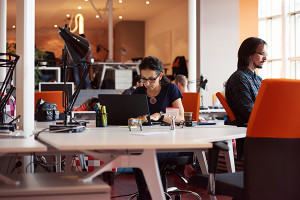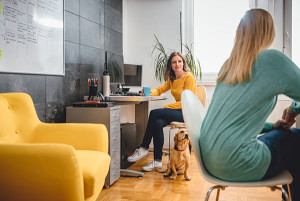Not Your Father’s Office Space
by Sheryl Mazirow | October 1, 2017 1:51 pm
Welcome to the brave, new world of office space in the Los Angeles market. It is comprised of neighborhoods, communities, huddle spaces, hoteling, benching, pathways, and—above all—collaborative space. Oh, and let’s not forget the ability to bring man’s best friend, our beloved dog, to work.
Today’s office space landscape is far different than it was a few years ago, and the driver in the Los Angeles area is the desire of tenants to secure what is known as creative office space. Although traditionally sought by technology firms, this trend has gone mainstream with law firms, real estate companies, accounting organizations and insurance companies now demanding corporate office space that is 180-degrees opposite of “our father’s office space.”
New Must-Haves Come At A Price
Today’s creative office environment often includes an “open ceiling” exposed plenum, which is the area between the structural floor and the dropped ceiling that houses air conditioning, heating ducts, and insulation. Some may consider this “unfinished” look to be cost effective to accomplish. But in actuality, it can be rather expensive to change traditional space into an exposed environment to create the desired look.
 [1]
[1]
Mazirow Commercial’s president Sheryl Mazirow states that creative office space includes “neighborhoods” where offsite or remote employees and visitors to the office can plugin and log-on in order to perform their tasks on an as-needed basis. Permanent office space is no longer necessary for these types of employees.
Clusters of open spaces are the hallmark of creative office space versus a row of offices along the window line with secretarial or staff bays on the interior in traditional corporate office space. This open landscape is designed to promote interaction and collaboration among employees or departments, known as “neighborhoods,” within an organization. There often is no specific office assigned to a particular individual. Employees “plugin” and “log on” and perform their work task at different areas within the premises. Private conversations take place in a “huddle” area, which is often simply an alcove. Offsite employees who drop into the office and all visitors in the office are said to be “hoteling.”
Creative office space has a lack of walls to create enclosed spaces. This all seems like an easy, efficient way to provide workspace. Unfortunately, it isn’t. Tenant improvement costs are incurred due to opening up the ceiling to expose the plenum areas and as well as for demolition of the previously designed traditional offices. Core drilling into concrete floors for electrical and data drops can get expensive but is critical in these open landscape plans. Often “soft walls” made of fabric, which can be decorative to enhance the atmosphere, may or may not be movable and used within the premises to define a specific area.
Generally, creative office space in Los Angeles translates into to a boatload of employees. Therefore, density has become a major topic of discussion during the lease negotiations, and the load usage of electricity is a hot button issue due to the number and variety of gadgets that employees use daily in this type of office environment.
Parking, Kitchens, Dogs And Bikes
 [2]
[2]
The allowance for dogs and bicycles in the workplace are a new norm for creative space leasees. A non-traditional open landscape promotes interaction and collaboration among employees. And natural light is being demanded more and more, according to Sheryl Mazirow, President and founder of Mazirow Commercial, Inc.
Parking also is another important issue that must be addressed in lease negotiations. Often, the standard of three parking spaces for each one thousand square feet leased, known as the 3/1,000 Rule, is not adequate and was undoubtedly established when the building was constructed. Landlords can later go back to the city and request a modification, but this often is difficult to achieve. There are other options such as re-striping the parking lot to include more spaces, providing a valet service to jockey cars into other space around the building, or converting reserved parking spaces—especially those that are vacant the majority of time—into unreserved ones to accommodate daily employee and visitor demand.
Kitchens no longer satisfy the strict need for food in creative office space, and they have replaced conference rooms as significant topics of negotiation. The “look” and “brand” that the organization wishes to display to the world is now imprinted in the kitchen area. Often the kitchen will be the central point within the premises, no longer regulated to an interior windowless space, but the premier lounge location. Kitchens have become gathering areas to work, create, and collaborate.
Under the Rules and Regulations section of a lease, a tenant will normally see the prohibition of dogs, but the creative office user is big on dogs. This can be a difficult but humorous negotiation. We just completed a lease that hinged on how many dogs are allowed into the building, how many times a week one dog can enter the office, and how much it can weigh.
Additionally, there is usually a prohibition on bicycles in the workplace or worksite. However, this is a common mode of the transportation for the creative office user. Institutional ownership of buildings is being challenged to achieve a comfort level of permitting dogs versus bicycles, where the landlord provides racks and bikers the locks. But we’re seeing new buildings stepping up to the challenge by providing restrooms with lockers and showers in addition to bike storage options.
Natural Light
The window line also is critical issue because users want to be as close as possible to the outside environment and natural light. Users also want easy access to parking and amenities; restaurants within walking distance are a must.
Multi-story buildings from in the 1970s are very challenged to accommodate creative office space given the architectural design that was popular then and their location in “concrete jungles,” but we are seeing large, single-story industrial buildings redesigned for creative office space. Additional parking and exterior green areas for gathering are being incorporated into these projects, but they come at significantly higher rental rates.
Evolution
The world of office space continues to evolve. It would have been hard to imagine a few years ago that a transaction would come down to how many dogs may visit your office per week and how much they are permitted to weigh. Even negotiating where bicycles can be safely stored would have drawn strange looks. While it sounds like this “could only happen in Los Angeles,” the trend of creative office space has spread to San Francisco, Seattle, Houston, Chicago, New York City, and Miami. Get ready for a new and fascinating era of working in an office. •
- [Image]: http://www.socalprofessional.com/wp-content/uploads/2017/10/SoCalPro-Not-Your-Fathers-Office-Space-NEIGHBORHOODS-Sheryl-Mazirow.jpg
- [Image]: http://www.socalprofessional.com/wp-content/uploads/2017/10/SoCalPro-Not-Your-Fathers-Office-Space-CREATIVE-SPACE-Sheryl-Mazirow.jpg
Source URL: http://www.socalprofessional.com/2017/10/not-your-fathers-office-space/